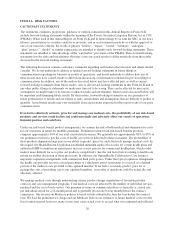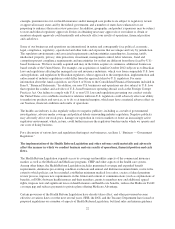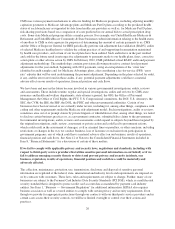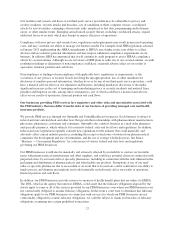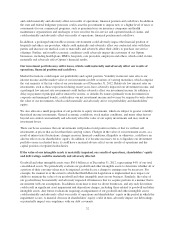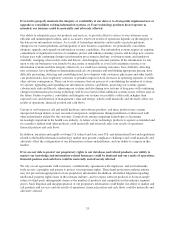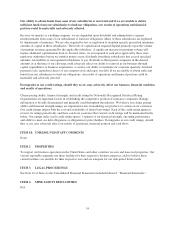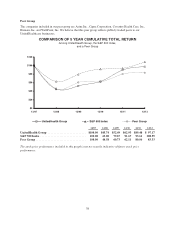United Healthcare 2012 Annual Report Download - page 31
Download and view the complete annual report
Please find page 31 of the 2012 United Healthcare annual report below. You can navigate through the pages in the report by either clicking on the pages listed below, or by using the keyword search tool below to find specific information within the annual report.for administrative efficiency and marketing leverage, and other organizational structures that physicians,
hospitals and other care providers choose may change the way that these providers interact with us and may
change the competitive landscape. Such organizations or groups of physicians may compete directly with us,
which may impact our relationships with these providers or affect the way that we price our products and
estimate our costs and may require us to incur costs to change our operations, and our results of operations,
financial position and cash flows could be adversely affected. In addition, if these providers refuse to contract
with us, use their market position to negotiate favorable contracts or place us at a competitive disadvantage, our
ability to market products or to be profitable in those areas could be materially and adversely affected.
We have capitation arrangements with some physicians, hospitals and other health care providers. Capitation
arrangements limit our exposure to the risk of increasing medical costs, but expose us to risk related to the
adequacy of the financial and medical care resources of the health care provider. To the extent that a capitated
health care provider organization faces financial difficulties or otherwise is unable to perform its obligations
under the capitation arrangement, we may be held responsible for unpaid health care claims that should have
been the responsibility of the capitated health care provider and for which we have already paid the provider
under the capitation arrangement. Further, payment or other disputes between a primary care provider and
specialists with whom the primary care provider contracts can result in a disruption in the provision of services to
our members or a reduction in the services available to our members. There can be no assurance that health care
providers with whom we contract will properly manage the costs of services, maintain financial solvency or
avoid disputes with other providers. Any of these events could have a material adverse effect on the provision of
services to our members and our operations.
Some providers that render services to our members do not have contracts with us. In those cases, we do not have
a pre-established understanding about the amount of compensation that is due to the provider for services
rendered to our members. In some states, the amount of compensation due to these out-of-network providers is
defined by law or regulation, but in most instances, it is either not defined or it is established by a standard that
does not clearly specify dollar terms. In some instances, providers may believe that they are underpaid for their
services and may either litigate or arbitrate their dispute with us or try to recover from our members the
difference between what we have paid them and the amount they charged us. For example, we are involved in
litigation with out-of-network providers, as described in more detail in “Litigation Matters” in Note 12 of Notes
to the Consolidated Financial Statements included in Item 8, “Financial Statements.”
The success of certain Optum businesses, particularly Collaborative Care, depends on maintaining satisfactory
physician relationships. The primary care physicians that practice medicine or contract with our affiliated physician
organizations could terminate their provider contracts or otherwise become unable or unwilling to continue
practicing medicine or contracting with us. If we are unable to maintain satisfactory relationships with primary care
physicians, or to retain enrollees following the departure of a physician, our revenues could be materially and
adversely affected. In addition, our affiliated physician organizations contract with health insurance and HMO
competitors of UnitedHealthcare. If our affiliated physician organizations fail to maintain relationships with these
health insurance or HMO companies, or to adequately price their contracts with these third party payers, our results
of operations, financial position and cash flows could be materially and adversely affected.
In addition, physicians, hospitals, pharmaceutical benefit service providers, pharmaceutical manufacturers, and
certain health care providers are customers of our Optum businesses. Given the importance of health care
providers and other constituents to our businesses, failure to maintain satisfactory relationships with them could
materially and adversely affect our results of operations, financial position and cash flows.
Because of the nature of our business, we are routinely subject to various litigation actions, which could
damage our reputation and, if resolved unfavorably, could result in substantial penalties and/or monetary
damages and materially and adversely affect our results of operations, financial position and cash flows.
Because of the nature of our business, we are routinely made party to a variety of legal actions related to, among
other things, the design, management and delivery of our product and service offerings. These matters have
29



